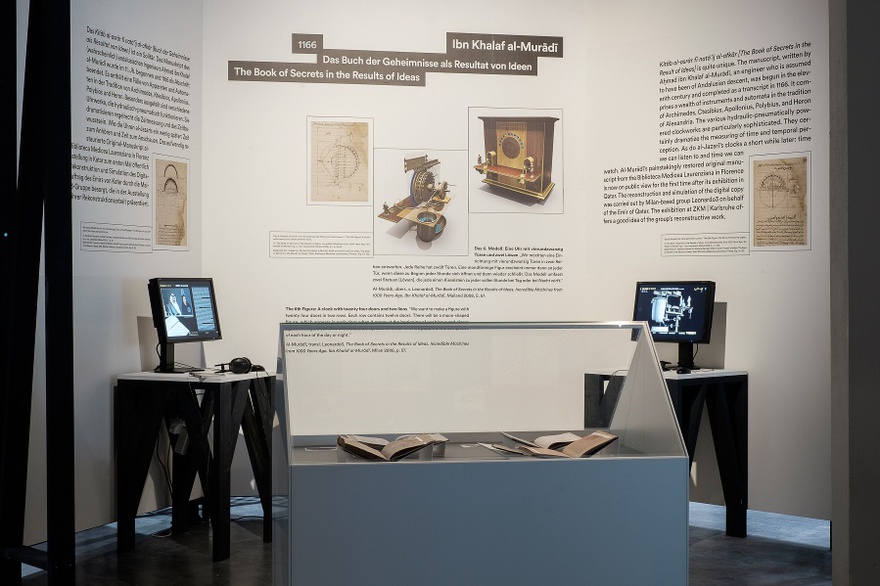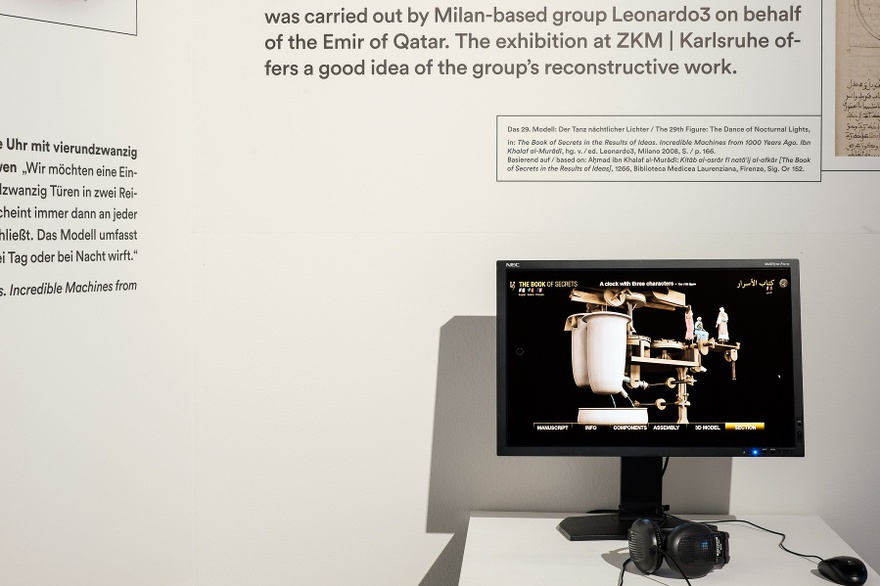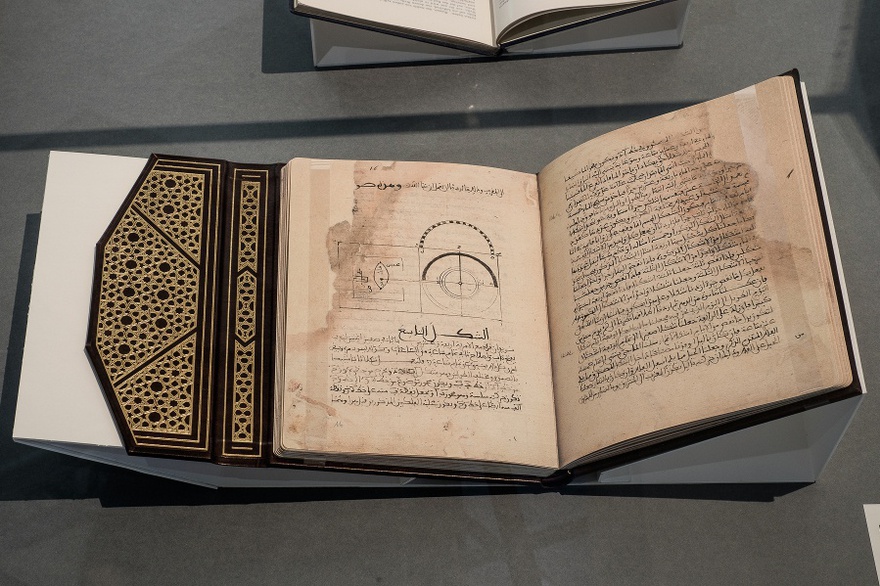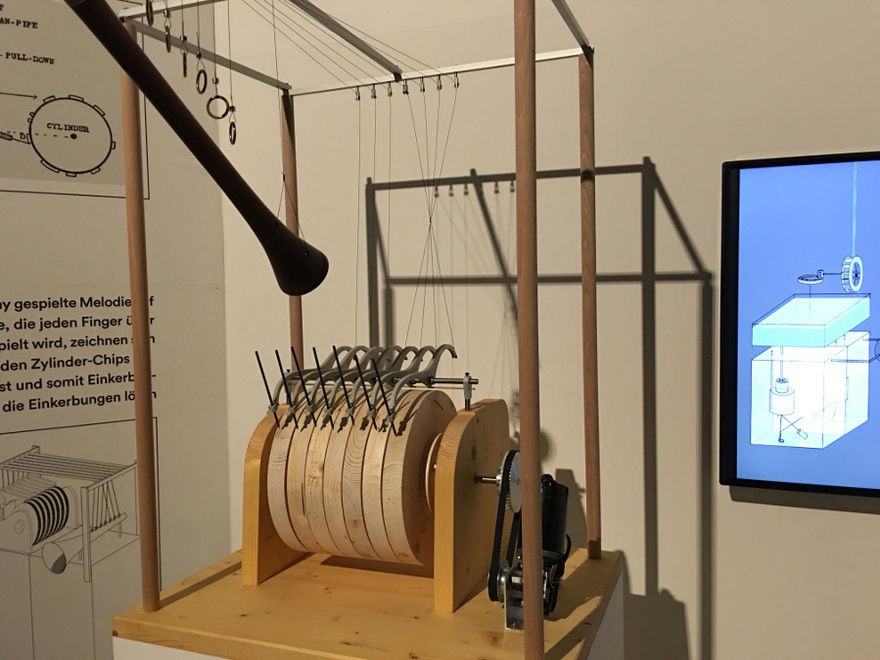Reviews
Globale: Allah’s Automata
Throughout history, it has been the prerogative of each dominant civilization to presume its own pre-eminence, that knowledge and culture originates with its own discoveries, to obliterate the identity of previous nations and to appropriate knowledge and resources as one's own. Such cultural chauvinism necessarily minimizes the impressions that previous civilizations have inscribed into the cultural landscape, an attitude which in previous eras might have gone unnoticed. Within the context of our contracted globalized world, it produces a parochialism that feeds xenophobia and the demand for assimilation, providing fodder for conflict and misunderstandings between nations and the sub-cultures within nations. The current ZKM exhibition, GLOBALE: Allah's Automata (2015–2016), seeks to expand and re-orient the tributaries feeding Western civilization by recovering and re-contextualizing a forgotten history of the Muslim World. It offers a brief excursion into the golden age of Islamic culture, focusing on exceptional examples and exploring the rich and fascinating world of the automated mechanical devices developed by Muslim engineers between the ninth and thirteenth centuries. Through a critical examination of ancient Islamic texts on science and engineering and the reconstruction of key mechanical constructions, the exhibition initiates an archaeology of technology and automata that implicitly renegotiates the question 'How did the Renaissance begin?', or more specifically, 'Was there a renaissance before the Renaissance?'
The Enlightenment period is typically characterized as laying the foundations for modernity and enabling the eventual separation of knowledge production from religious institutional control, which finally allowed science to flourish as its own discipline. Integral to this process was the influence of seminal Greek and Latin texts on philosophy and mathematics. Most of the knowledge of these ancient cultures was contained in scrolls which are thought to have been lost in several fires that destroyed the bulk of the holdings in Library of Alexandria. History, in the Western world, is said to have reached a standstill between the fall of the Roman Empire and the beginning of the Enlightenment, a period of nearly 1000 years, which, until quite recently, was too easily dismissed as the 'Dark Ages'.
Paradoxically, during this period of 'darkness', we find the Islamic world experiencing its own renaissance, a thirst for knowledge, and an accelerating cultural dominance generating untold wealth and a comparable acceleration in empire building that leads to its own Enlightenment period. For a period of 500 years, Arabic, the language of the vast Islamic Empire that in the early eighth century stretched from India to Al-Andalus in Spain, becomes the international language of science and culture. It is during this period that we witness in the Islamic world an aspiration to build mechanical devices that operate as 'automata', a word deriving from Greeks of the Hellenistic period who are known to have designed the first automata, translated literally as 'self-acting'.
Particularly spectacular among these mechanical advances is Ibn al-Razzaz al-Jazari's automatic 'Elephant Clock', which provides insight into the origins of modern automation and robotics. Reconstructed by engineers and programmers from Bursa in Anatolia and displayed in the exhibition, this seven metre high sculpture harnesses Greek water technology to create a self-propelling automatic time-keeping device capable of accurate time calculation in minutes and hours. Reflecting the diverse cultural composite that was then the Islamic civilization, the clock cunningly incorporates multiple references: an Indian elephant, an Egyptian phoenix, Arabian figures, a Persian carpet, and Chinese dragons. The number of hours is shown on a black disk at the top of the clock, while the number of minutes into the hour is demonstrated by the movement of a pen in the hands of a scribe who sits inside the howdah, or throne, on the Elephant's back. The construction implicitly emphasizes the interdependence between time and knowledge and, through the scribe's act of record-keeping, between knowledge and history, suggesting that history, like time, is meaningless unless documented. The movements of the clock are regulated by a floating bowl that sits in a tank of water inside the body of the elephant. At the bottom of the bowl is a tiny hole, drilled to have a precise diameter, which allows the water to fill the bowl in a perfect motion of one-half hour. A system of pulleys causes the scribe's pen to move, thus marking the passing minutes on the hour. Once completely submerged, the bowl sinks which instigates a dramatic sequence of events that alters the hour and eventually causes the process to repeat itself.
Al-Jazari of Bagdad lived during the Ayyubid dynasty in the thirteenth century. In addition to the 'Elephant Clock', Al-Jazari created a formidable number of mechanical devices that revolutionized engineering at the time. Many of these are described in Al-Jazari's The Book of Ingenious Devices (c. 830 AD), an exact facsimile copy of which is featured in the exhibition on loan from the Vatican Library.
Indeed, the exhibition brings together four manuscripts on the construction of machines for the first time, from Bagdad, Northern Mesopotamia and Andalusia. On show is Al-Jazari's Compendium on the Theory and Praxis of the Mechanical Arts (1206 AD), a seminal work on engineering from the golden age of Arab-Islamic scientific knowledge. Somewhat remarkably also in the exhibition is The Book of Secrets in the Results of Ideas, which sets out technical accomplishments of the Andalusian engineer Ahmad ibn Khalaf al-Muradi, originally written in the twelfth century. The manuscript was reconstructed by a group of scholars from Milan, whose painstaking reconstruction work is also on show in the exhibition.
The Banu Musa's treatise, The Instrument which Plays by Itself (850 AD) describes a programmable universal musical instrument. This ingenious device has also been reconstructed and may be seen in the exhibition together with an animation explaining how its hydraulic and pneumatic drives work.
The Banu Musa were three brothers who, throughout the ninth century, were instrumental in introducing Greek science to the Muslim world by providing precise translations of Greek texts while also undertaking original research that would accelerate scientific learning. The second book of the Banu Musa, Book of the Organ, includes 100 inventions by Ahmad, one of the brothers, of which the instrument that plays itself is perhaps the most significant for an archelogy of automata because it outlines plans for a robotic device that imitated a human form to execute the music. The form of a humanoid flutist would be accomplished by disguising the entire apparatus inside the body of a humanoid structure, the fingers acting as levers, creating air conduits in the body which are directed toward the mouth.
The engineers sought to create an instrument that could be programmed to play through a series of melodies at varying speeds and rhythms through the use of cylinders with moveable pins. Such technologies form the basis of musical instruments such as the Pythagorean organ today, almost 800 years later. The two dimensional projection of such a programme inscribed into cylinders was transposed in the eighteenth century to a punch card construction used to control automated machines such as weaving looms, player pianos and trumpets.
It is ironic to think that technology and automata should have found their beginnings in efforts to praise God and that were originally described as mechanical objectifications of the cosmic spirit. These inventions of automata from the Islamic world, while drawing on the traditions of Greek Alexandria and Byzantium, introduced spectacular innovations that did not emerge in Europe until the modern era: permanent energy supply, universalism, motion and programmability.
As Edward Said reminds us, Islam is typically described within the Western context as a threatening 'Other', a picture that develops during the colonial period and which he describes as Orientalism. Islam's presentation as Other has, according to Said, much to do with the control and dominance of Europe and the West generally in the Islamic world. Allah's Automata dismantles clear cut separations between cultures and questions the rigid notions that separate us from the Other, suggesting that far from being separate and discrete, even our Western cultural dominance, here translated as scientific and technological, may find its roots within the very paradigms we seek to dominate and describe as Other.[1]
GLOBALE: Allah's Automata, curated by Siegfried Zielinski in cooperation with Eckhard Fürlus and Daniel Irrgang, is on show at ZKM Karlsruhe until 7 August 2016.
[1] David Barsamian, 'Edward Said Interview', The Progressive, 31 October 2001, www.progressive.org/mag_barssaid









